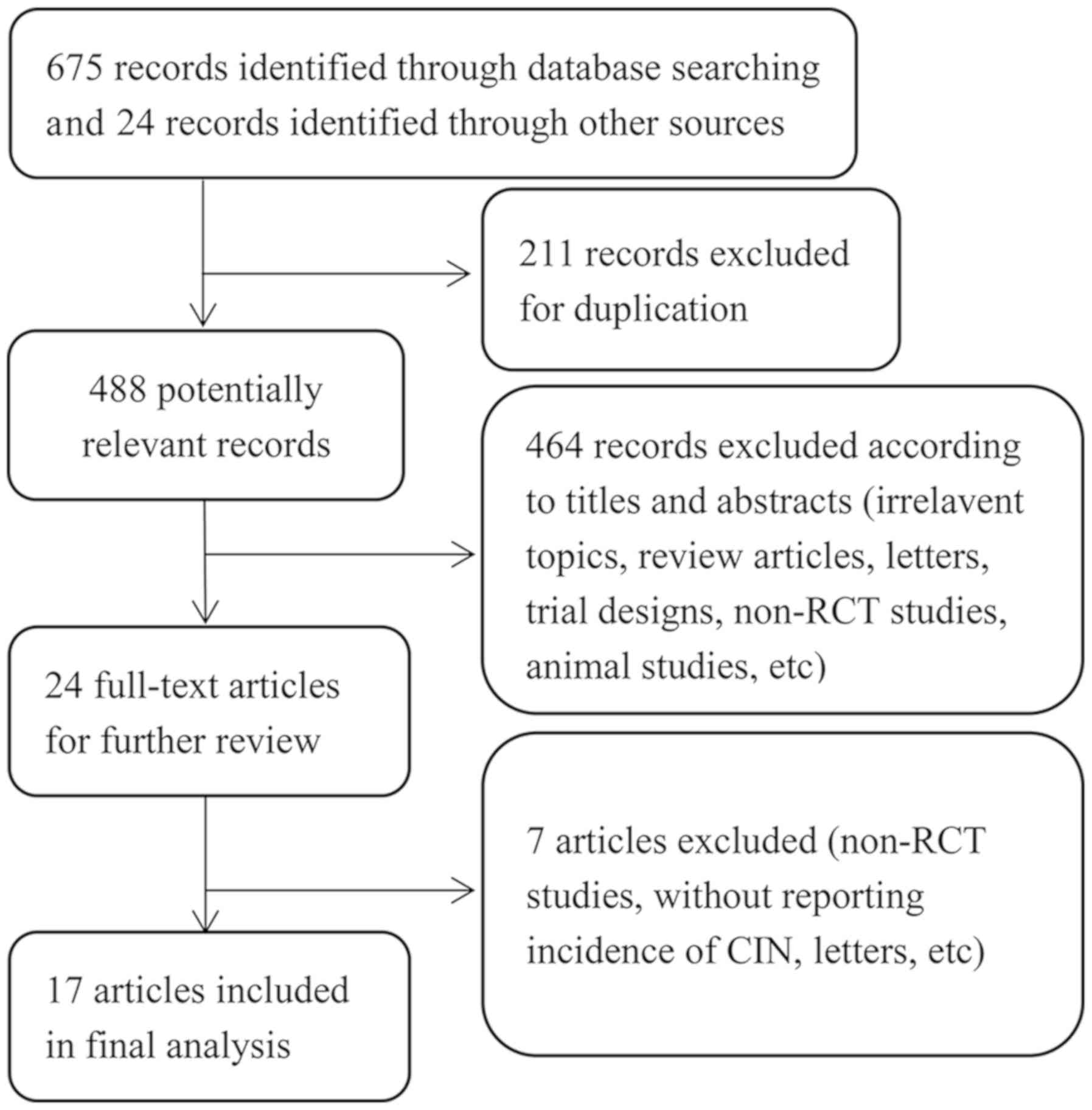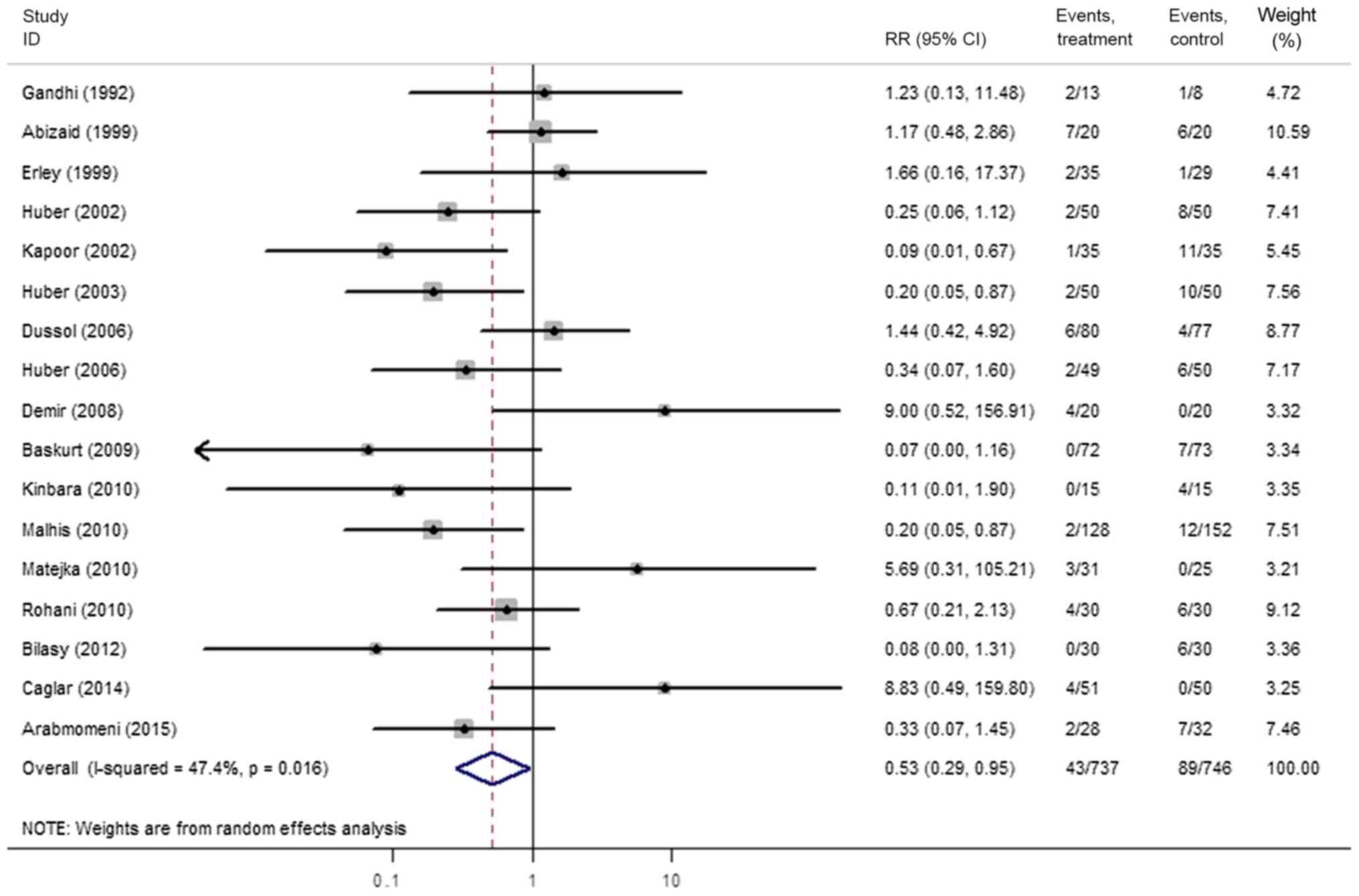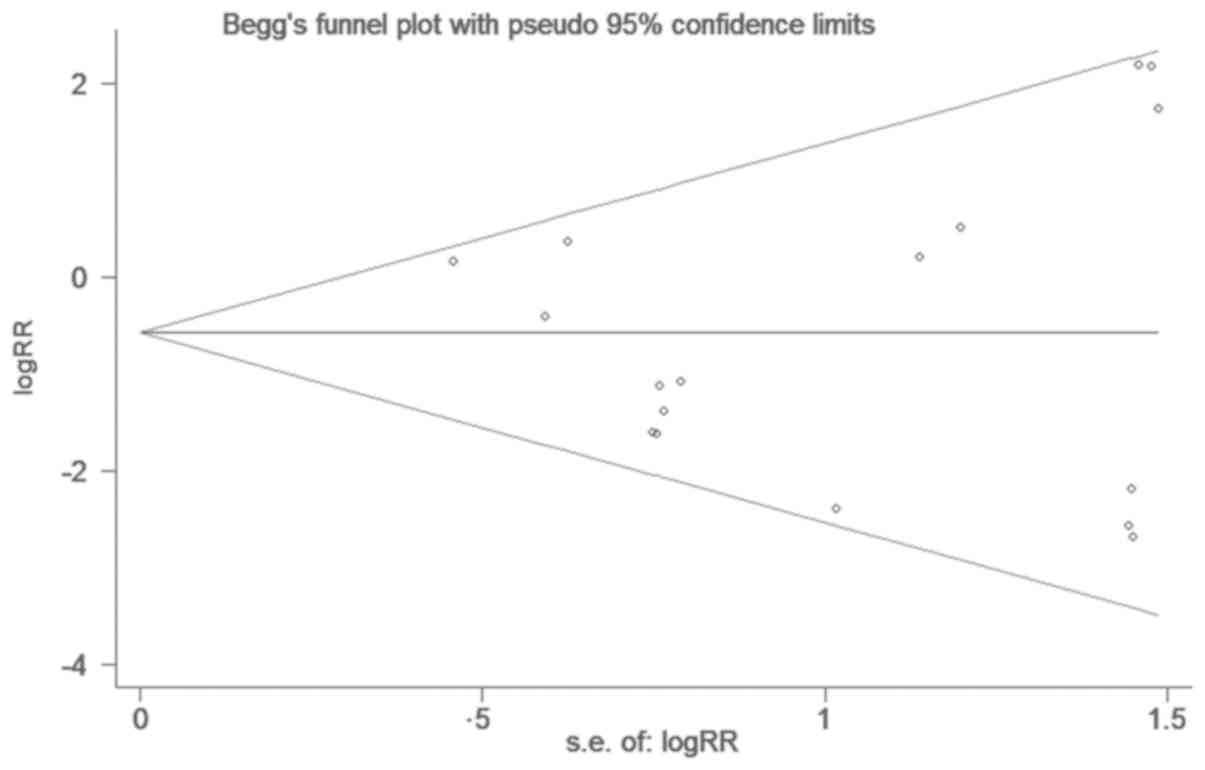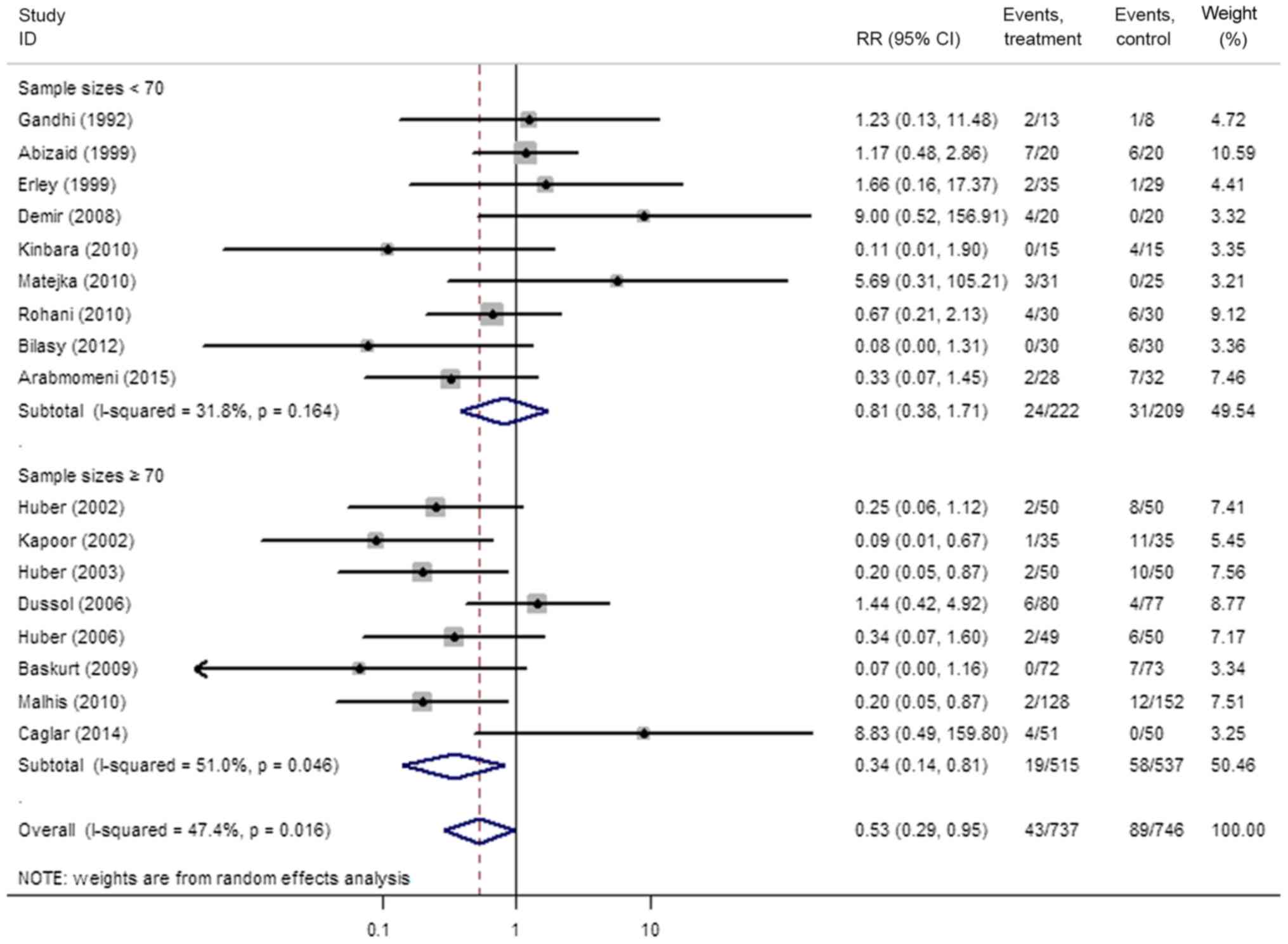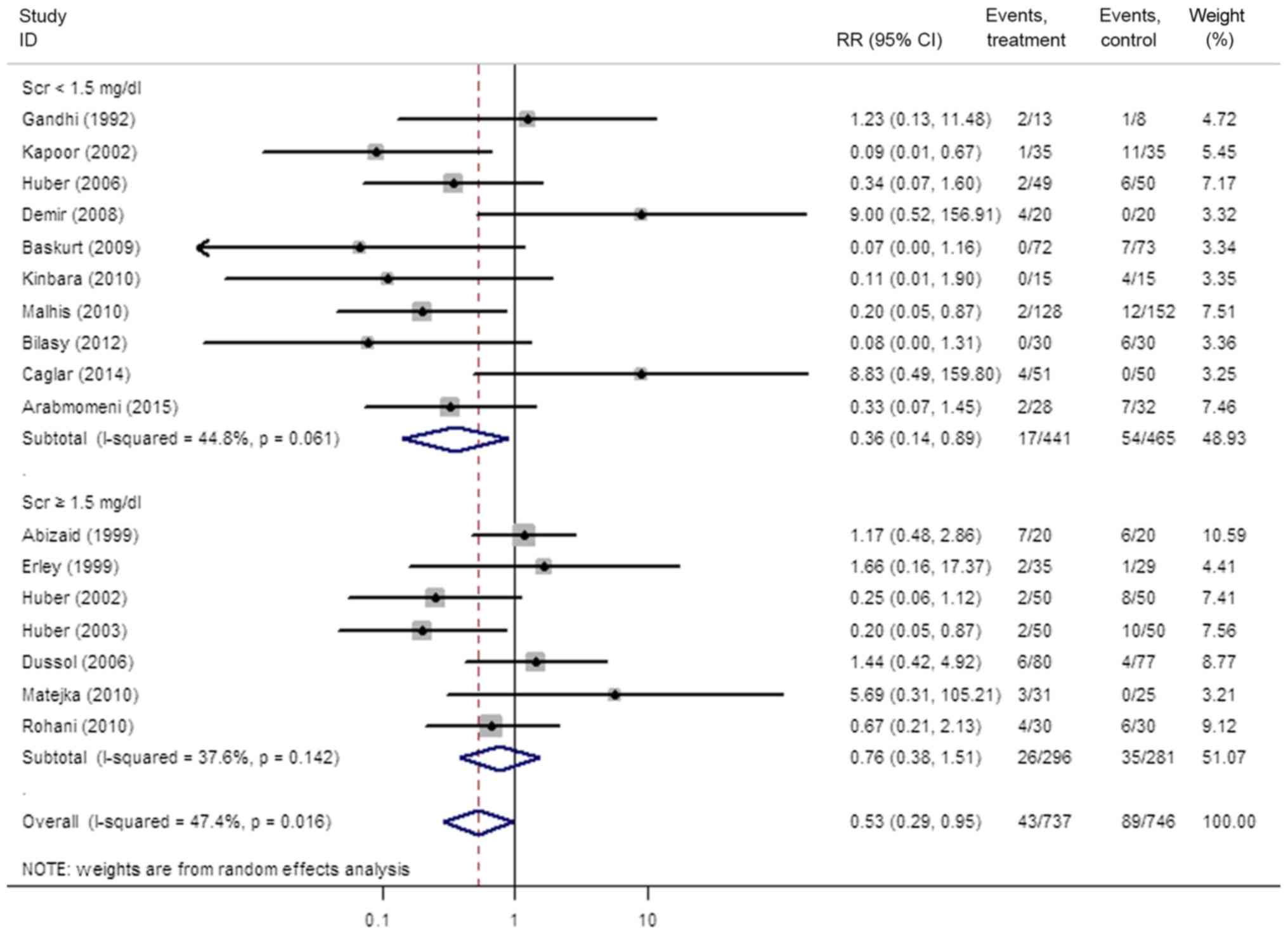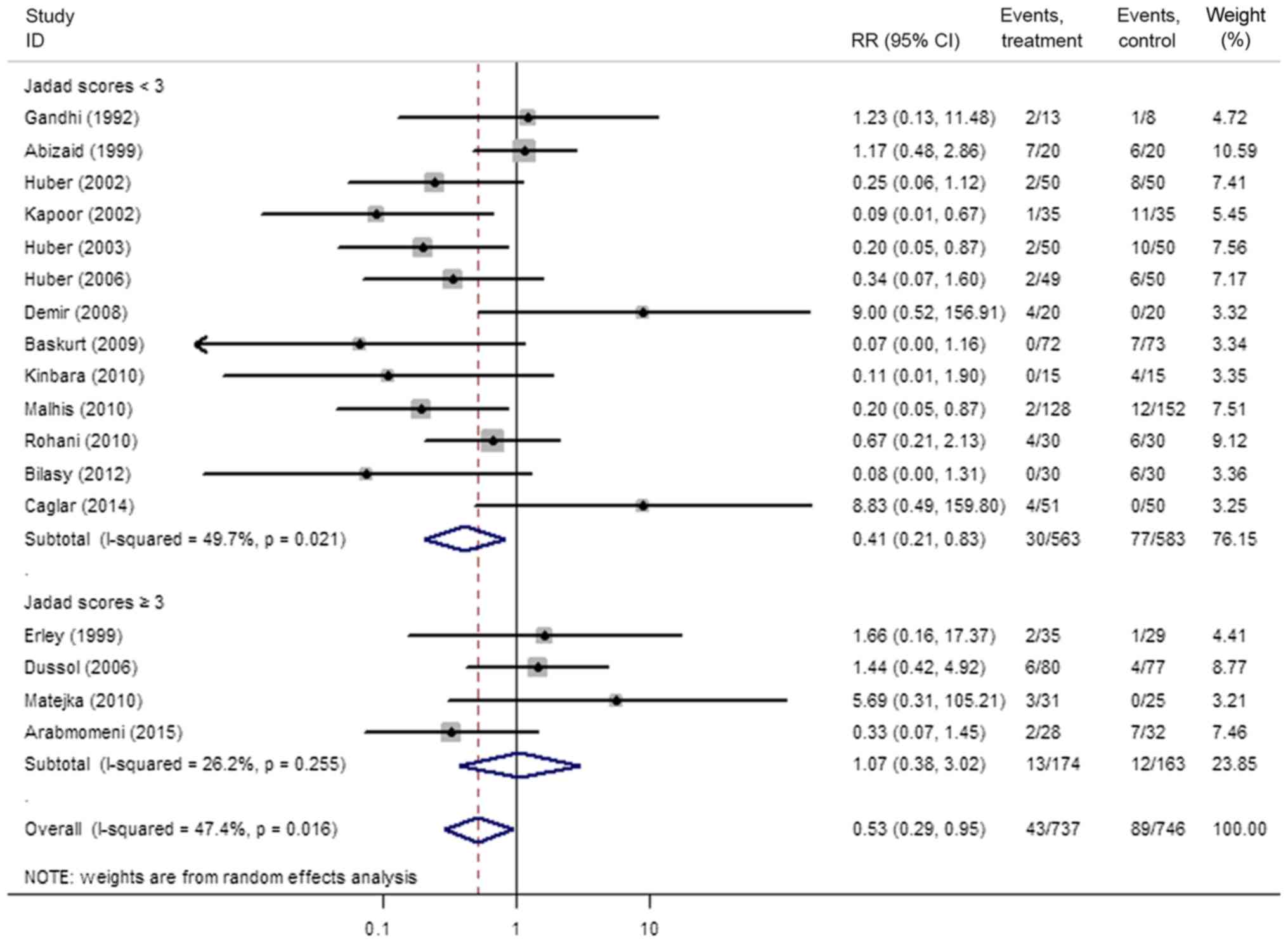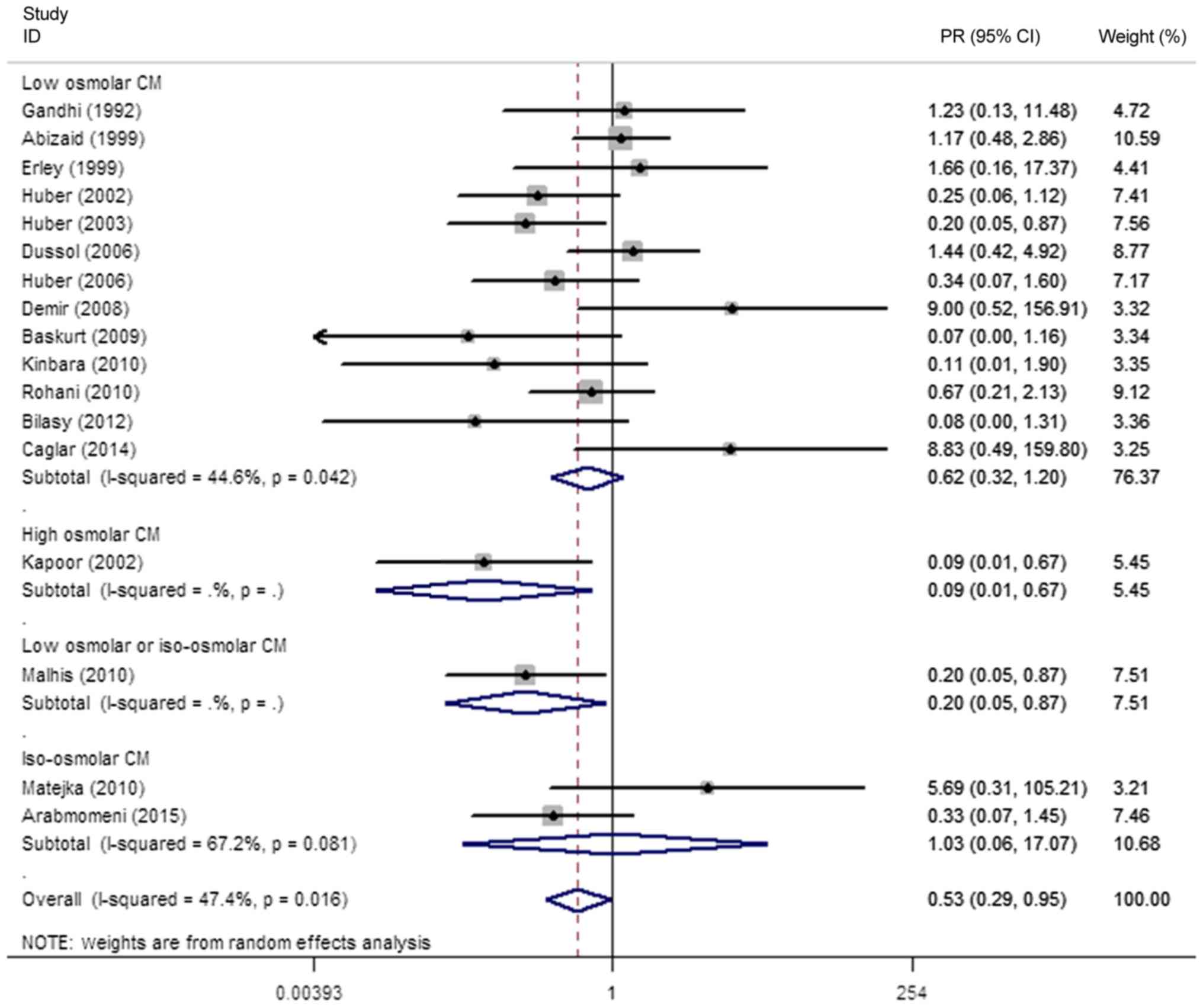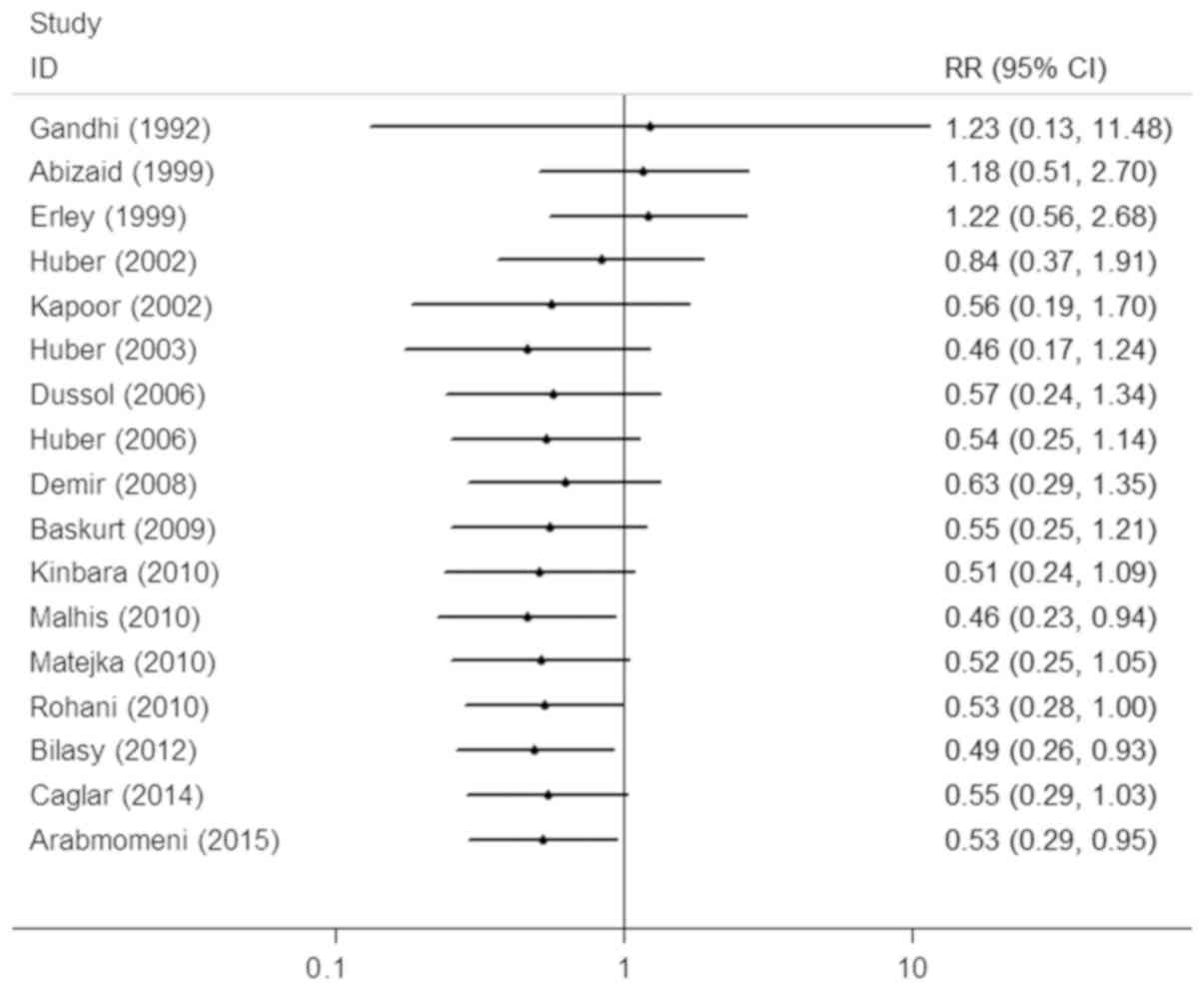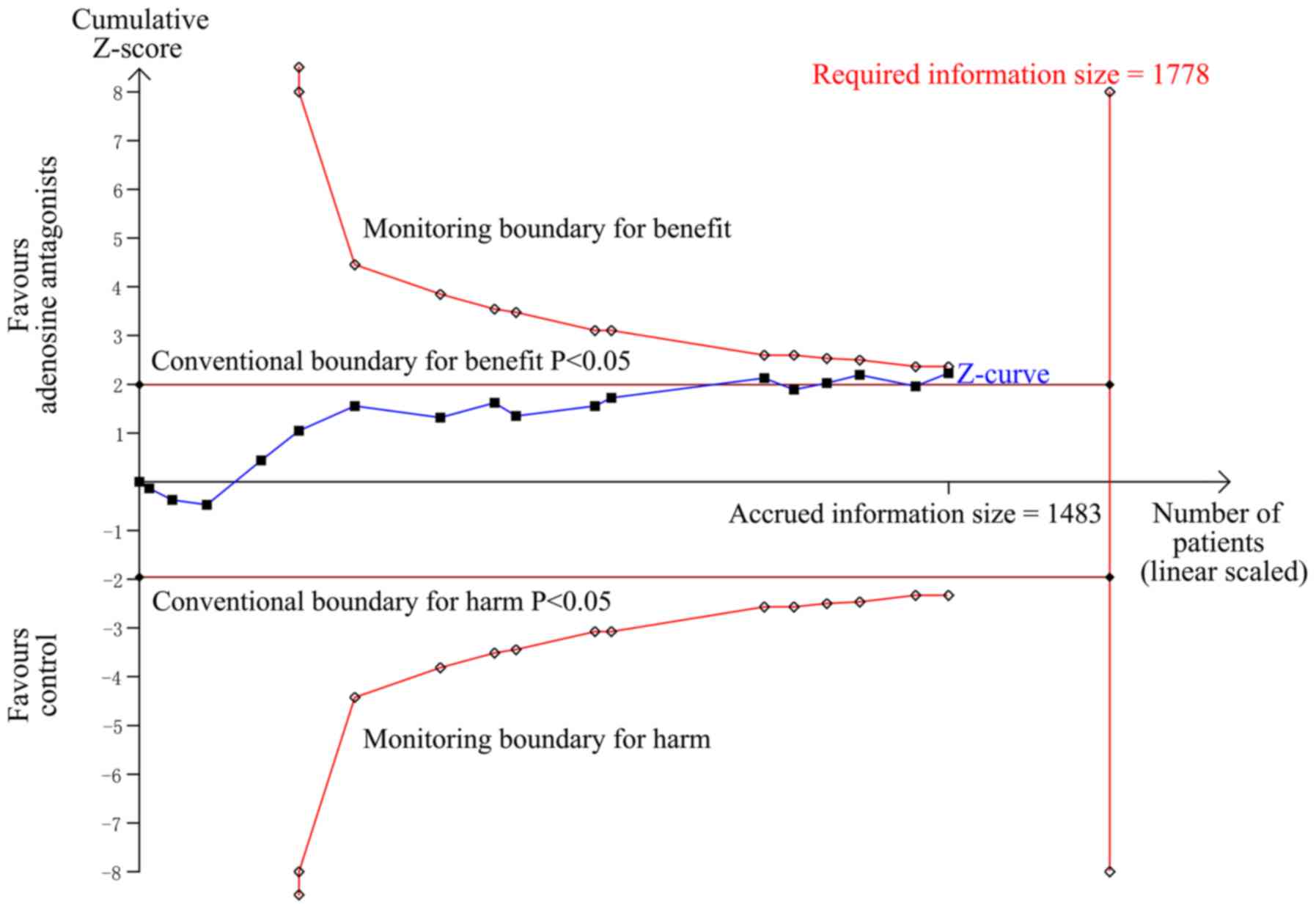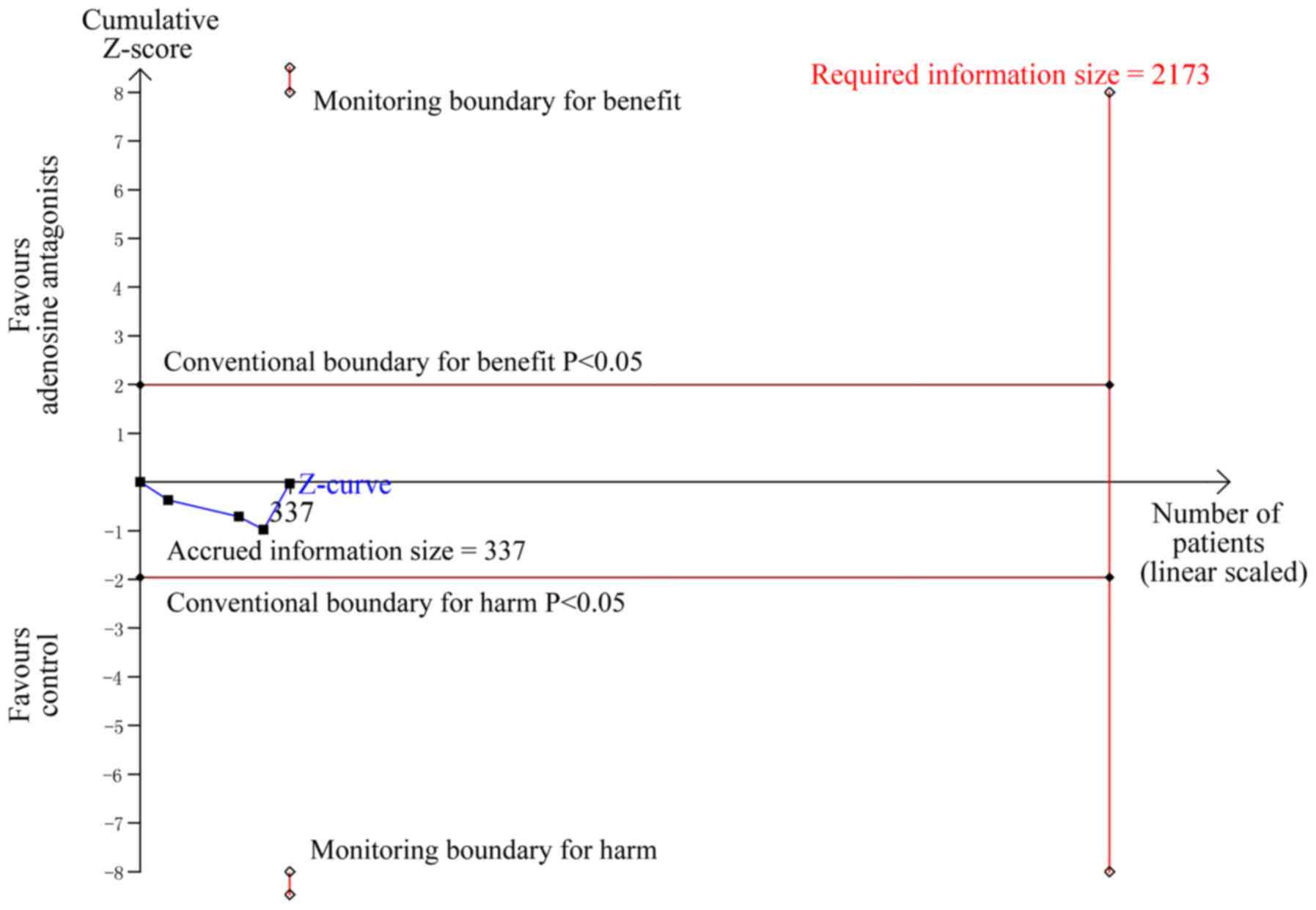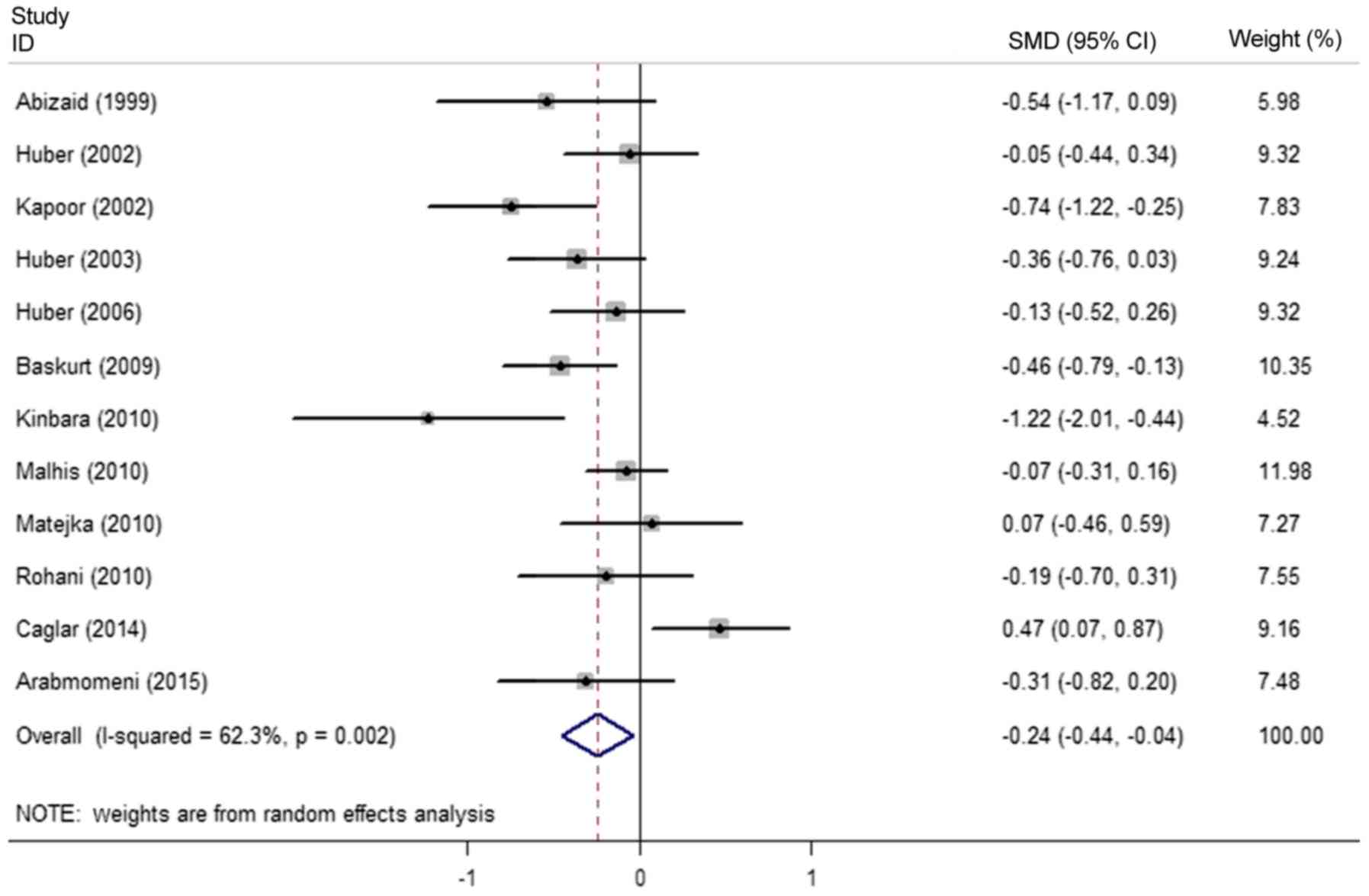Introduction
With the development of diagnostic and
interventional technology, the number of patients in whom contrast
media (CM) are administered is continuously increasing. Those
patients receiving intravascular CM administration are at risk of
contrast-induced nephropathy (CIN). As one of the most common types
of hospital-acquired kidney injury (accounting for 11–12% of all
cases) (1), CIN is usually defined
as an increase in serum creatinine (SCr) levels by ≥0.5 mg/dl or
≥25% within 48 or 72 h following CM exposure (2). Numerous factors may affect the risk of
CIN, including age, hypertension, anemia, DM, atrial fibrillation,
pre-existing renal dysfunction, insufficient circulation volume,
type and volume of contrast agents and concomitant administration
of nephrotoxic agents (3–6).
CIN may lead to dialysis, prolonged hospitalization
and even increased mortality (7,8).
Effective prevention strategies are urgently required in clinics.
By now, peri-procedural hydration with saline, administration of
only the minimum required volume of CM, usage of low- or
iso-osmolar CM and removal of nephrotoxic drugs have been widely
accepted as methods to prevent CIN (9–11). Among
the preventive medicines, adenosine antagonists (AAs) are of great
interest. Animal studies have demonstrated that AAs increase renal
blood flow and the glomerular filtration rate (GFR) after CM
exposure by interrupting adenosine-induced vasoconstriction
(12). However, several randomized
controlled trials (RCTs) and meta-analyses have not consistently
indicated a benefit of AAs in CIN prevention (13–15).
Among those meta-analyses, only the most recent one suggested that
AAs reduce the incidence of CIN (15). However, when a traditional
meta-analysis is updated with new trials, the risk of a
false-positive or false-negative result increases due to repeated
significance testing (16,17). To deal with this problem, trial
sequential analysis (TSA) was recommended by the Copenhagen trial
unit. As an interim analysis in a single trial, TSA may provide an
information size calculation to ensure the reliability of the
pooled estimate (18,19). Furthermore, in TSA, the monitoring
boundaries adjusted by random errors may detect the possibility of
a false-positive or false-negative result before the required
information size (RIS) is achieved (20,21).
To determine the effect of AA in preventing CIN, an
updated meta-analysis with inclusion of several recently published
RCTs was performed. Furthermore, given the small sample sizes of
the published trials and the dangers of overestimating the efficacy
with traditional meta-analyses, TSA was also performed to assess
the reliability of the pooled estimates.
Materials and methods
Search strategy
The literature search was performed using the
Medline, Embase, Web of Science and Cochrane databases to retrieve
all RCTs on AAs in preventing CIN published until December 31, 2017
by two investigators (HZ and QZ). The search terms were ‘adenosine
antagonists’, ‘theophylline’, ‘aminophylline’, ‘contrast-induced
nephropathy’, ‘contrast-induced nephrotoxicity’, ‘contrast-medium
nephrotoxicity’, ‘contrast medium-induced nephropathy’,
‘contrast-induced acute kidney injury’, ‘contrast-associated acute
kidney injury’ and ‘contrast-associated nephropathy’. Trials were
limited to those with human subjects only. A manual search was then
performed (by HZ and QZ) on the results provided by the
aforementioned databases. Before retrieving the full texts, the
authors of the current study reviewed the titles and abstracts
first. Full texts, rather than abstracts or meeting proceedings,
were included. The references of the articles retrieved were also
reviewed to identify potential trials for inclusion.
Selection criteria
Studies that met the following criteria were
included: RCTs referring to CIN prevention; the intervention was
AAs vs. control; aside from AA usage, there was no different
intervention between the two arms in each trial; incidence of CIN
must be reported.
Data extraction and quality
assessment
Two investigators (HZ and QZ) separately extracted
data from all of the primary studies meeting the selection
criteria. The following information of each study was assembled:
Sample size, rate of diabetes mellitus (DM), type and dose of CM,
baseline renal function, outcome measures, protocols for the
treatment with adenosine receptor antagonists and hydration
protocols. The primary outcome measure was the development of CIN,
defined as an increase in the SCr level by ≥0.5 mg/dl or ≥25%
within 48–72 h following CM exposure (2). The secondary outcome measure was the
SCr level after CM administration. Items that were used to assess
the quality of studies included methods of randomization, methods
of blinding, placebo control, reporting of losses to follow-up and
reasons for losses to follow-up. The overall quality of studies was
evaluated by determining the Jadad scores (22). In the case of any disagreement on the
extracted data, a third reviewer (XL) would adjudicate.
Meta-analysis
Effect sizes for dichotomous data (incidence of CIN)
were presented as risk ratios (RRs) and 95% confidence intervals
(CIs), and for continuous data (SCr levels after CM
administration), effect sizes were presented as the standardized
mean differences (SMDs) and 95% CIs. Heterogeneity was reported
using I2 statistics, with values of 0–30%, 31–50% and
>50% representing low, moderate and significant heterogeneity,
respectively. For low heterogeneity, a fixed-effects model was
used; otherwise, a random-effects model was used. The meta-analysis
was performed using STATA version 12.0 (StataCorp LP, College
Station, TX, USA).
Publication bias and sensitivity
analysis
Begg's test and Egger's test were performed to
assess publication bias. A Begg's funnel plot was also generated.
Sensitivity analysis was used to assess the effect of an individual
study on the pooled estimate by removing one study at a time.
Meta-regression and subgroup
analysis
Meta-regression was performed to identify the
underlying sources of heterogeneity, which included sample sizes,
volumes and osmotic pressures of CM, baseline renal function,
proportion of patients with DM, type and dose of AAs, routes of AA
administration, study quality and peri-procedural hydration
protocols. Subgroup analyses were also performed according to
sample size, osmotic pressure of CM, baseline renal function and
study quality.
Cumulative meta-analysis
Cumulative analysis was performed to observe the
tendency of the pooled RRs for the incidence of CIN according to
the publication year.
Trial sequential analysis
Meta-analyses are commonly updated when new evidence
appears. However, repetitive testing of accumulating data runs the
risk of producing random errors. To deal with this problem, TSA is
used, in which the monitoring boundaries may avoid false-positive
results and provide the benefit or futility of an intervention as
early as possible. In the present study, the TSA of the incidence
of CIN was performed using the TSA program version 0.9 beta
(www.ctu.dk/tsa) with α=5% and 1-β=80%. The
anticipated relative risk reduction was based on the pooled
estimate of available trials. If the Z-curve crossed the
conventional boundary of significance (Z=±1.96, P<0.05) but not
the trial sequential significance boundary, the pooled estimate was
considered to be at risk of false-positive results.
Correspondingly, if the Z-curve neither crossed the conventional
boundary of significance nor the trial sequential futility
boundary, the pooled estimate was considered to be at risk of
false-negative results. However, when the Z-curve crossed the RIS
or the monitoring boundaries before the RIS is achieved, the pooled
estimate was considered to be sufficiently reliable to make a firm
conclusion (20).
Results
Identification of studies
From the initial literature search, 699 potentially
relevant articles were identified. After the titles and abstracts
of those articles were reviewed independently, 24 articles were
regarded to be potentially qualified for inclusion. The full texts
of those articles were searched. Subsequently, seven trials were
excluded from the meta-analysis for various reasons (e.g., non-RCT
studies, no reporting of CIN incidence, letters). Finally, 17 RCTs
were identified and analyzed. The selection process of the present
meta-analysis is presented in Fig.
1.
Features of studies included
The baseline characteristics of the 17 studies
included are presented in Table I.
These RCTs included 1,483 patients in total. The number of
participants in each trial ranged from 30 to 280 (23–39). The
percentage of patients with DM ranged from 0 to 100%. A total of 3
studies used aminophylline (24,33,36) and
the others used theophylline (23,25,32,34,35,37–39).
Most studies included used iso- or low-osmolar CM, except for one
study that used high-osmolar CM (27). AAs were administered either
intravenously or orally in those trials. In 9 studies, CIN was
defined as an increase in SCr levels by ≥0.5 mg/dl from baseline
(25,26,28–30,32,33,36,38). In
two studies, CIN was defined as a ≥25% increase in SCr levels from
baseline (24,27), and CIN was defined as either in five
studies (31,34,35,37,39). In
most studies, there was no difference in the baseline SCr between
the AA and control groups (23,24,26–33,35–39).
However, in two studies, the baseline SCr was unfavorable for the
AA group (25,34).
 | Table I.Baseline characteristics of studies
included in the present meta-analysis. |
Table I.
Baseline characteristics of studies
included in the present meta-analysis.
| Author (year) | Diabetes mellitus
(%) | Patients (I/C) | Contrast type | Contrast medium
volume (ml) | Baseline SCr
(I/C) | CIN definition | Theo or amino
protocol | Hydration
protocol | (Refs.) |
|---|
| Gandhi et al
(1992) | NR | 21 (13/8) | Low osmolar | NR | NR | NR | Theo 125 mg orally
twice daily for 24 h prior to and 48 h after contrast exposure | None | (23) |
| Abizaid et
al (1999) | 55 | 40 (20/20) | Low osmolar | 190 | 1.9±0.4 vs.
2.3±0.8 | SCr ↑ ≥25% within
48 h | Amino 4 mg/kg
bolus, then 0.4 mg/kg/h i.v. for 2 h prior to contrast
exposure | 0.45% saline
solution 1 ml/kg/h i.v. for 12 h prior to and 12 h after contrast
exposure | (24) |
| Erley et al
(1999) | 30 | 64 (35/29) | Low osmolar | 125 | 1.9±0.5 vs.
1.7±0.4 | SCr ↑ ≥0.5 mg/dl
within 72 h | Theo 270 mg orally
every morning and 540 mg orally every night from 2 days before to
exposure 3 days after contrast exposure | 2-2.5 L fluid
orally or i.v. for 24 h prior to and 24 h after contrast | (25) |
| Huber et al
(2002) | 34 | 100 (50/50) | Low osmolar | 207 | 2.07±0.94 vs.
1.92±0.76 | SCr ↑ ≥0.5 mg/dl
within 48 h | Theo 200 mg i.v. 30
min prior to contrast exposure | 2 l/d advised | (26) |
| Kapoor et al
(2002) | 100 | 70 (35/35) | High osmolar | 79 | 1.16±0.18 vs.
1.19±0.23 | SCr ↑ ≥25% within
48 h | Theo 200 mg orally
twice daily for 24 h prior to and 48 h after contrast exposure | 0.9% saline
solution 1 ml/kg/h i.v. for 12 h prior to and 12 h after contrast
exposure | (27) |
| Huber et al
(2003) | 31 | 100 (50/50) | Low osmolar | 207 | 1.65±0.41 vs.
1.72±0.69 | SCr ↑ ≥0.5 mg/dl
within 48 h | Theo 200 mg i.v. 30
min prior to contrast exposure | 2 l/d advised | (28) |
| Dussol et al
(2006) | 28 | 157 (80/77) | Low osmolar | 124 | 2.42±1.28 vs.
2.35±0.95 | SCr ↑ ≥0.5 mg/dl
within 48 h | Theo 5 mg/kg orally
in 1 dose 1 h prior to contrast exposure | 0.9% saline
solution 15 ml/kg i.v. for 6 h prior to contrast exposure | (29) |
| Huber et al
(2006) | 26 | 99 (49/50) | Low osmolar | 154 | 1.28±0.74 vs.
1.25±0.74 | SCr ↑ ≥0.5 mg/dl
within 48 h | Theo 200 mg i.v. 30
min prior to contrast exposure | None | (30) |
| Demir et al
(2008) | NR | 40 (20/20) | Low osmolar | 100 | 0.84±0.27 vs.
0.88±0.23 | SCr ↑ ≥0.5 mg/dl or
≥25% within 72 h | Theo 200 mg orally
every morning from 1 day before to 1 day prior to contrast
exposure | 2 l 0.9% saline
solution i.v. for 24 h prior to and 24 h after contrast
exposure | (31) |
| Baskurt et
al (2009) | 30 | 145 (72/73) | Low osmolar | 123 | 1.47±0.27 vs.
1.39±0.24 | SCr ↑ ≥0.5 mg/dl
within 48 h | Theo 200 mg orally
twice daily on the day prior to and the day of contrast
exposure | 0.9% saline
solution 1 ml/kg/h i.v. for 12 h prior to and 12 h after contrast
exposure | (32) |
| Kinbara et
al (2010) | 40 | 30 (15/15) | Low osmolar | 142 | 0.97±0.29 vs.
0.94±0.21 | SCr ↑ ≥0.5 mg/dl
within 48 h | Amino 250 mg i.v.
30 min prior to contrast exposure | 0.9% saline
solution 1 ml/kg/h i.v. for 30 min prior to and 10 h after contrast
exposure | (33) |
| Malhis et al
(2010) | 33 | 280 (128/152) | Low osmolar or
iso-osmolar | 141 | 1.38±0.79 8 vs.
1.21±0.4 | SCr ↑ ≥0.5 mg/dl or
≥25% within 48 h | Theo 200 mg orally
twice daily for 24 h prior to and 48 h after contrast exposure; or
theo 200 mg i.v. 30 min prior to and 200 mg orally twice daily for
48 h after contrast exposure | 1–2 l sodium
bicarbonate (150 mEq/l) i.v. for 12 h after contrast exposure | (34) |
| Matejka et
al (2010) | 75 | 56 (31/25) | Iso-osmolar | 95 | 2.02±0.45 vs.
2.06±0.59 | SCr ↑ ≥0.5 mg/dl or
≥25% within 48 h | Theo 205.7 mg i.v.
90 min prior to contrast exposure | 0.9% saline
solution 0.5 ml/kg/d i.v. for 1 day after contrast exposure | (35) |
| Rohani (2010) | 18 | 60 (30/30) | Low osmolar | 205 | 1.93±0.21 vs.
1.84±0.54 | SCr ↑ ≥0.5 mg/dl
within 48 h | Amino 250 mg i.v.
30 min prior to contrast exposure | 0.9% saline
solution i.v. for 3–12 h prior to 1.0–1.5 ml/kg/h and 6–24 h after
contrast exposure | (36) |
| Bilasy et al
(2012) | 50 | 60 (30/30) | Low osmolar | 117 | 1.54±0.73 vs.
1.34±0.66 | SCr ↑ ≥0.5 mg/dl or
≥25% within 72 h | Theo 200 mg i.v. 30
min prior to contrast exposure | 0.9% saline
solution 1 ml/kg/h i.v. for 12 h prior to and 12 h after contrast
exposure | (37) |
| Caglar et al
(2014) | 41 | 101 (51/50) | Low osmolar | 100 | 1.39±0.2 vs.
1.36±0.2 | SCr ↑ ≥0.5 mg/dl
within 48 h | Theo 200 mg orally
twice daily for the day prior to and the day of contrast
exposure | Sodium bicarbonate
(154 mEq/l) 3 ml/kg/h i.v. for 1 h before and 1 ml/kg/h i.v. for 6
h after contrast exposure | (38) |
| Arabmomeni et
al (2015) | 73 | 60 (28/32) | Iso-osmolar | 143 | 1.08±0.22 vs.
1.08±0.22 | SCr ↑ ≥0.5 mg/dl or
≥25% within 48 h | Theo 200 mg orally
twice daily for 24 h prior to and 48 h after contrast exposure | 0.9% saline
solution 1 ml/kg/h i.v. for 12 h prior to and 12 h after contrast
exposure | (39) |
Quality assessment of trials
Of the trials included, 4 exhibited high quality
(Jadad scores ≥3) (25,29,35,39). The
other studies were identified as having low quality due to lack of
randomization processes, methods for blinding or losses to
follow-up (Jadad scores <3) (23,24,26–28,30–34,36–38). The
overall quality of studies assessed by the Jadad scores is
presented in Table II.
 | Table II.Quality of included studies in this
meta-analysis. |
Table II.
Quality of included studies in this
meta-analysis.
| Author (year) | Jadad
scorea | Inclusion/exclusion
criteria specified | Randomization
process described | Use of any
blinding | Placebo
control | Reported loss to
follow-up | Reason for loss to
follow-up provided | Baseline
differences between groups | Power
calculation | (Refs.) |
|---|
| Gandhi et al
(1992) | 2 | Yes | No | Yes | Yes | No | NS | NS | No | (23) |
| Abizaid et
al (1999) | 2 | Yes | Yes | No | No | Yes | No | No | No | (24) |
| Erley et al
(1999) | 4 | Yes | No | Yes | Yes | Yes | Yes | Yes | No | (25) |
| Huber et al
(2002) | 2 | Yes | No | Yes | Yes | No | NS | Yes | No | (26) |
| Kapoor et al
(2002) | 1 | Yes | No | No | No | No | NS | No | No | (27) |
| Huber et al
(2003) | 1 | Yes | No | Yes | Yes | No | NS | No | Yes | (28) |
| Dussol et al
(2006) | 3 | Yes | Yes | No | No | Yes | Yes | No | No | (29) |
| Huber et al
(2006) | 1 | Yes | No | No | No | No | NS | No | Yes | (30) |
| Demir et al
(2008) | 2 | Yes | No | No | No | Yes | No | No | No | (31) |
| Baskurt et
al (2009) | 2 | Yes | Yes | No | No | No | NS | No | No | (32) |
| Kinbara et
al (2010) | 1 | Yes | No | No | No | No | NS | No | No | (33) |
| Malhis et al
(2010) | 1 | Yes | Yes | No | No | No | NS | No | No | (34) |
| Matejka et
al (2010) | 5 | Yes | Yes | Yes | Yes | Yes | Yes | No | Yes | (35) |
| Rohani (2010) | 2 | Yes | No | Yes | Yes | No | NS | No | No | (36) |
| Bilasy et al
(2012) | 2 | Yes | Yes | Yes | No | No | NS | No | No | (37) |
| Caglar et al
(2014) | 2 | Yes | Yes | No | No | No | NS | No | No | (38) |
| Arabmomeni et
al (2015) | 5 | Yes | Yes | Yes | Yes | Yes | Yes | No | Yes | (39) |
Publication bias
According to Begg's test (P=0.773) and Egger's test
(P=0.760), there was no publication bias across the included
trials. The funnel plot is presented in Fig. 2. Sensitivity analysis indicated that
no single trial significantly influenced the pooled estimate.
Efficacy of AA to reduce the incidence
of CIN
A total of 1,483 patients were included from 17 RCTs
reporting data on the incidence of CIN, with 737 and 746 patients
allocated to the AA and control groups, respectively. The overall
incidence of CIN was 8.90%. CIN occurred in 5.83 and 11.93% of the
subjects in the AA and control groups, respectively. There was
moderate heterogeneity across the studies (I2=47.4%;
P=0.016) and therefore, a random-effects model was used for
meta-analysis. The pooled result revealed that AAs significantly
reduced the incidence of CIN (RR=0.53; 95% CI, 0.29–0.95; P=0.034;
Fig. 3).
Meta-regression revealed that the sample size (≥70
vs. <70; P=0.180), volume (≥150 vs. <150 ml; P=0.827) and
osmotic pressures of CM (P=0.708), baseline renal function (≥1.5
vs. <1.5 mg/dl; P=0.210), proportion of subjects with DM (≥50
vs. <50%; P=0.635), type of AA (theophylline vs. aminophylline;
P=0.672) and dose of theophylline and aminophylline (>250 vs.
≤250 mg; P=0.180), route of AA administration (oral vs.
intravenous; P=0.239), study quality (Jadad scores, ≥3 vs. <3;
P=0.205), and peri-procedural hydration protocols (with hydration
vs. without hydration; P=0.936) did not explain for the
heterogeneity of the CIN prevention effect of AAs across studies.
Subgroup analyses indicated that AAs reduced the incidence of CIN
in trials with a sample size of ≥70 (RR=0.34; 95% CI, 0.14–0.81;
P=0.015; Fig. 4), baseline SCr
<1.5 mg/dl (RR=0.36; 95% CI, 0.14–0.89; P=0.028; Fig. 5), and of low quality (RR=0.41; 95%
CI, 0.21–0.83; P=0.013; Fig. 6), but
not in trials with sample sizes <70 (RR=0.81; 95% CI, 0.38–1.71;
P=0.581; Fig. 4), baseline SCr ≥1.5
mg/dl (RR=0.76; 95% CI, 0.38–1.51; P=0.435; Fig. 5) and of high quality (RR=1.07; 95%
CI, 0.38–3.02; P=0.901; Fig. 6),
which may in part explain for the underlying source of
heterogeneity. When trials were grouped by osmotic pressure of CM,
AAs did not significantly reduce the incidence of CIN neither in
trials using low-osmolar CM (RR=0.62; 95% CI, 0.32–1.20; P=0.159;
Fig. 7) nor in trials using
iso-osmolar CM (RR=1.03; 95% CI, 0.06–17.07; P=0.981; Fig. 7). However, since only one trial used
high-osmolar CM (27), no pooled
analysis was possible, although the trial did indicate a
significant decrease in the incidence of CIN by theophylline.
Furthermore, in another trial, patients receiving either or low-
and iso-osmolar CM were assessed (34). This trial did not specify which of
the patients were treated by low- and iso-osmolar CM. Thus, in this
trial, although administration of theophylline significantly
reduces the incidence of CIN, the effects of AAs on the CIN induced
by different osmotic pressures of CM could not be analyzed
separately.
As the studies were added one by one, the cumulative
meta-analysis indicated that the value of the pooled RRs was
unstable and the corresponding 95% CIs did not become narrower, at
times even with a P>0.05 (Fig.
8).
In the TSA, the anticipated relative risk reduction,
which was based on the pooled estimate of available trials, was 47%
for the incidence of CIN. The RIS of 1,778 was not reached. In
addition, the cumulative Z-curve crossed the conventional boundary
for benefit (P=0.05) but not the trial sequential monitoring
boundary for benefit, indicating a >5% false-positive risk for
the result of a 47% reduction in the incidence of CIN with AAs vs.
control (Fig. 9). TSA was also
exclusively performed in high-quality studies. The RIS was not
reached and the Z-curve did not cross the conventional or trial
sequential significance boundary (Fig.
10).
SCr level after CM administration
Among the studies included in the present
meta-analysis, three trials did not contain data on the SCr level
after CM administration. A total of 12 trials reported the SCr
levels at 48 h after CM administration. Only two trials reported on
the SCr levels at 72 h after CM administration. Thus, a pooled
analysis on the SCr levels at 48 h after CM administration was
performed, revealing and a significant reduction in the AA vs.
control group (SMD, −0.24 mg/dl; 95% CI, −0.44 to −0.04; P=0.019;
I2=62.3%; Fig. 11).
Dialysis and mortality
A total of 10 trials reported on the cases that
required dialysis after CM administration. Out of 501 patients in
the AA group, 3 (0.60%) required dialysis, while none of the 517
patients in the control group required dialysis. In-hospital
mortality was reported by only four trials. Mortality occurred in 1
(0.69%) of 145 patients in the AA group and 3 (2.07%) of 145
patients in the control group. With those low dialysis and
mortality rates, it was impossible to perform meta-analyses on
these two outcome measures.
Discussion
The present study included 17 RCTs, and of 1,483 the
participants, 132 experienced CIN [AA group: 43/737 (5.83%);
control group: 89/746 (11.93%)]. The meta-analysis suggested that
AAs significantly reduced the risk of CIN and the SCr level after
CM exposure. In addition, TSA indicated that the trials included
failed to provide firm evidence for a 47% relative risk reduction
in the incidence of CIN.
The pathophysiological mechanism of CIN remain
incompletely understood. It is widely accepted that the direct
toxicity of CM, reduced renal blood flow caused by vasoconstrictors
and oxidative stress caused by reactive oxygen species are mainly
responsible for the development of CIN. The direct toxicity of CM
toward renal tubule cells is the primary factor. When irritated by
CM, renal tubule cells release various vasoconstrictors and
generate reactive oxygen species that induce programmed cell death
(40,41). Adenosine is the most important
vasoconstrictor involved in CIN, which causes vasoconstriction of
the vas afferens by activating adenosine 1 receptor (42). Thus, by blocking adenosine 1
receptor, AAs increase renal blood flow and the GFR (43).
Several clinical studies have investigated AAs for
preventing CIN. However, contradictory results were obtained. Due
to the small sample sizes of those studies, meta-analyses were
performed to determine the protective effect of AAs. There have
been three previous meta-analyses in this field. The meta-analysis
of seven RCTs by Ix et al (13) indicated that AA administration caused
a decrease in the SCr levels after CM exposure (SMD= −0.13 mg/dl;
95% CI, −0.22 to −0.06), but they did not assess the incidence of
CIN as an outcome. A later meta-analysis including nine RCTs by
Bagshaw and Ghali (14) reported
that AAs did not reduce the incidence of CIN (odds ratio, 0.40; 95%
CI, 0.14–1.16) but improved renal function after CM exposure
compared with the controls (SCr, SMD= −0.17 mg/dl; 95% CI, −0.28 to
−0.06). The most recent meta-analysis of 13 RCTs by Dai et
al (15) indicated that AAs not
only improved renal function after CM exposure (SCr, SMD= −0.31
mg/dl; 95% CI, −0.50 to −0.11) but also reduced the incidence of
CIN (RR=0.48; 95% CI, 0.26–0.89). However, as meta-analyses are
updated, the false-positive risk increases. In meta-analyses, a
single significance test can be considered reliable once the
required information size is surpassed (20,21).
However, meta-analyses are often performed before required
information sizes are reached and are commonly updated when new
trials are published. When meta-analyses are updated (before
required information sizes are reached), they are repeatedly
subjected to the significance testing over time. The repeated
significance testing on accumulating data is known to inflate the
overall false-positive risk. Simulation studies suggest that if
repeated significance testing is done in meta-analyses and
P<0.05 was considered to indicate a statistical significant
difference, then the actual false-positive risk will be between 10
and 30% (17). This phenomenon is
commonly known as ‘multiplicity due to repeated significance
testing’ (17). TSA may help
minimize the risk of a false-positive or false-negative result in a
meta-analysis by RISs and monitoring boundaries. In the present
study, the TSA on the incidence of CIN indicated that the Z-curve
neither crossed the trial sequential significance boundary nor
reached RIS, indicating that it was not possible to draw a reliable
conclusion of a 47% reduction in the incidence of CIN and another
295 subjects were required to reach the RIS. Some of the included
studies were indicated to be of low quality. To minimize the
effects of these low-quality studies on the results of the
meta-analysis, TSA was repeated with only high-quality studies
included. This did not markedly alter the results of the analysis,
and the results still implied that the benefit of AAs in CIN could
not be reliably determined.
Using regression analysis, Dai et al
(15) indicated that the baseline
SCr and study quality partly explained for the heterogeneity in
their meta-analysis. However, in the present study, no source of
heterogeneity was detected by regression analysis. This may have
been caused by the newly added articles. Compared with the
meta-analysis by Dai et al (15), the present study included four other
trials. The baseline SCr was <1.5 mg/dl in all those trials. The
sample sizes of those articles ranged from 40 to 101 and one of the
studies was of high quality. Furthermore, the quality of trials in
previous meta-analyses was reviewed. One study that was of high
quality was originally evaluated as having low quality.
Furthermore, although no source of heterogeneity was detected by
regression analysis, subgroup analyses indicated that AAs tended to
exhibit a greater prevention effect in trials with sample sizes of
≥70, baseline SCr of <1.5 mg/dl and low quality. However, the
significant benefit in low-quality studies may be due to underlying
bias. TSA revealed that 1,836 patients from high-quality studies
were required to draw a firm conclusion.
Attention should be paid to the safety of AAs. AAs
may induce adverse reactions and malignant arrhythmia is of
particular concern. In the present meta-analysis, six articles
including 658 subjects reported on the side effects of AAs
(26,29,30,35,38,39).
Some of those subjects experienced coronary heart disease, heart
failure and renal insufficiency, all of whom were at high risk for
arrhythmia induced by AAs. However, there was only one case of side
effects during the experimental period, namely of transient sinus
tachycardia after AA administration (26), but no malignant arrhythmia occurred.
Previous studies indicated that the side effects of AAs were likely
to occur only with serum concentrations of >20 g/ml (44). Therefore, the dosage and speed of AA
administration should be controlled, particularly when given
intravenously. Slow infusion of 250 mg theophylline or
aminophylline over 30 min may be recommended.
Of note, the present study had several limitations.
First, the limited number of high-quality studies may have limited
the reliability and credibility of the pooled results. Furthermore,
only few trials included in the present meta-analysis reported on
the side effects of AAs. Therefore, no pooled results were
available to assess the safety of AAs, which may induce arrhythmias
in patients with coronary heart disease and heart failure. Finally,
few trials were designed to assess the effect of AAs on mortality.
Thus, the present meta-analysis did not provide any evidence
regarding those important outcomes.
In conclusion, meta-analysis of the available data
from the RCTs indicated a significant reduction in the incidence of
CIN and the SCr levels with AAs vs. control for patients receiving
CM. However, TSA on the incidence of CIN detected the risk of a
false-positive result, indicating that more evidence is required to
ensure the benefit of AAs in preventing CIN. Future studies should
be of high quality and investigate the effect of AAs on clinically
relevant outcomes, including in-hospital morbidity, mortality and
the requirement for dialysis.
Acknowledgements
Not applicable.
Funding
No funding was received.
Availability of data and materials
The datasets used or analyzed during the current
study are available from the corresponding author on reasonable
request.
Authors' contributions
HZ conceived and designed the study. HZ, QZ and XL
performed the literature search and data extraction. HZ performed
the statistical analysis. HZ and QZ wrote the manuscript. HZ, QZ
and XL reviewed and edited the manuscript. All authors read and
approved the final manuscript.
Ethics approval and consent to
participate
Not applicable.
Patient consent for publication
Not applicable.
Competing interests
The authors declare that they have no competing
interests.
Glossary
Abbreviations
Abbreviations:
|
CIN
|
contrast-induced nephropathy
|
|
AA
|
adenosine antagonist
|
|
TSA
|
trial sequential analysis
|
|
RCT
|
randomized controlled trial
|
|
SCr
|
serum creatinine
|
|
CM
|
contrast media
|
|
GFR
|
glomerular filtration rate
|
|
RIS
|
required information size
|
|
RR
|
risk ratio
|
|
CI
|
confidence interval
|
|
SMD
|
standardized mean difference
|
References
|
1
|
Maliborski A, Zukowski P, Nowicki G and
Bogusławska R: Contrast-induced nephropathy-a review of current
literature and guidelines. Med Sci Monit. 17:RA199–RA204. 2011.
View Article : Google Scholar : PubMed/NCBI
|
|
2
|
McCullough PA: Contrast-induced acute
kidney injury. J Am Coll Cardiol. 51:1419–1428. 2008. View Article : Google Scholar : PubMed/NCBI
|
|
3
|
Mehran R, Aymong ED, Nikolsky E, Lasic Z,
Iakovou I, Fahy M, Mintz GS, Lansky AJ, Moses JW, Stone GW, et al:
A simple risk score for prediction of contrast-induced nephropathy
after percutaneous coronary intervention: Development and initial
validation. J Am Coll Cardiol. 44:1393–1399. 2004. View Article : Google Scholar : PubMed/NCBI
|
|
4
|
Kumar S, Nair RK, Aggarwal N, Abbot AK,
Muthukrishnan J and Kumar KV: Risk factors for contrast-induced
nephropathy after coronary angiography. Saudi J Kidney Dis Transpl.
28:318–324. 2017. View Article : Google Scholar : PubMed/NCBI
|
|
5
|
Valappil SP, Kunjukrishnapillai S, Iype M,
Koshy AG, Viswanathan S, Gupta PN, Velayudhan RV and Ali FM:
Predictors of contrast induced nephropathy and the applicability of
the Mehran risk score in high risk patients undergoing coronary
angioplasty-A study from a tertiary care center in South India.
Indian Heart J. 70:399–404. 2018. View Article : Google Scholar : PubMed/NCBI
|
|
6
|
Çinar T, Keskin M and Kaya A: Atrial
fibrillation: A new risk factor for contrast-induced nephropathy.
Angiology. Sep 27–2018.(Epub ahead of print).
|
|
7
|
Gruberg L, Mehran R, Dangas G, Mintz GS,
Waksman R, Kent KM, Pichard AD, Satler LF, Wu H and Leon MB: Acute
renal failure requiring dialysis after percutaneous coronary
interventions. Catheter Cardiovasc Interv. 52:409–416. 2001.
View Article : Google Scholar : PubMed/NCBI
|
|
8
|
Bashir AA, Kong V, Skinner D, Bruce J,
Laing G, Brysiewicz P and Clarke D: Contrast-induced nephropathy
following CT scan for trauma is not rare and is associated with
increased mortality in South African trauma patients. Eur J Trauma
Emerg Surg. Sep 18–2018.(Epub ahead of print). View Article : Google Scholar : PubMed/NCBI
|
|
9
|
Wyatt CM, Camargo M and Coca SG:
Prophylactic hydration to prevent contrast-induced nephropathy:
Much ado about nothing? Kidney Int. 92:4–6. 2017. View Article : Google Scholar : PubMed/NCBI
|
|
10
|
Ozkok S and Ozkok A: Contrast-induced
acute kidney injury: A review of practical points. World J Nephro.
6:86–99. 2017. View Article : Google Scholar
|
|
11
|
Trivedi HS, Moore H, Nasr S, Aggarwal K,
Agrawal A, Goel P and Hewett J: A randomized prospective trial to
assess the role of saline hydration on the development of contrast
nephrotoxicity. Nephron Clin Pract. 93:C29–C34. 2003. View Article : Google Scholar : PubMed/NCBI
|
|
12
|
Tepel M, Aspelin P and Lameire N:
Contrast-induced nephropathy: A clinical and evidence-based
approach. Circulation. 113:1799–1806. 2006. View Article : Google Scholar : PubMed/NCBI
|
|
13
|
Ix JH, McCulloch CE and Chertow GM:
Theophylline for the prevention of radiocontrast nephropathy: A
meta-analysis. Nephrol Dial Transplant. 19:2747–2753. 2004.
View Article : Google Scholar : PubMed/NCBI
|
|
14
|
Bagshaw SM and Ghali WA: Theophylline for
prevention of contrast-induced nephropathy: A systematic review and
meta-analysis. Arch Intern Med. 165:1087–1093. 2005. View Article : Google Scholar : PubMed/NCBI
|
|
15
|
Dai B, Liu Y, Fu L, Li Y, Zhang J and Mei
C: Effect of theophylline on prevention of contrast-induced acute
kidney injury: A meta-analysis of randomized controlled trials. Am
J Kidney Dis. 60:360–370. 2012. View Article : Google Scholar : PubMed/NCBI
|
|
16
|
Hu M, Cappeleri J and Lan KK: Applying the
law of the iterated logarithm to control type I error in cumulative
meta-analysis of binary outcomes. Clin Trials. 4:329–340. 2007.
View Article : Google Scholar : PubMed/NCBI
|
|
17
|
Borm GF and Donders AR: Updating
meta-analyses leads to larger type I errors than publication bias.
J Clin Epidemiol. 62:825–830.e10. 2009. View Article : Google Scholar : PubMed/NCBI
|
|
18
|
Brok J, Thorlund K, Gluud C and Wetterslev
J: Trial sequential analysis reveals insufficient information size
and potentially false positive results in many meta-analyses. J
Clin Epidemiol. 61:763–769. 2008. View Article : Google Scholar : PubMed/NCBI
|
|
19
|
Wetterslev J, Thorlund K, Brok J and Gluud
C: Estimating required information size by quantifying diversity in
a random-effects meta-analysis. BMC Med Res Methodol. 9:862009.
View Article : Google Scholar : PubMed/NCBI
|
|
20
|
Thorlund K, Devereaux PJ, Wetterslev J,
Guyatt G, Ioannidis JP, Thabane L, Gluud LL, Als-Nielsen B and
Gluud C: Can trial sequential monitoring boundaries reduce spurious
inferences from meta-analyses? Int J Epidemiol. 38:276–286. 2009.
View Article : Google Scholar : PubMed/NCBI
|
|
21
|
Wetterslev J, Thorlund K, Brok J and Gluud
C: Trial sequential analysis may establish when firm evidence is
reached in cumulative meta-analysis. J Clin Epidemiol. 61:64–75.
2008. View Article : Google Scholar : PubMed/NCBI
|
|
22
|
Jadad AR, Moore RA, Carroll D, Jenkinson
C, Reynolds DJ, Gavaghan DJ and McQuay HJ: Assessing the quality of
reports of randomized clinical trials: Is blinding necessary?
Control Clin Trials. 17:1–12. 1996. View Article : Google Scholar : PubMed/NCBI
|
|
23
|
Gandhi MR, Brown P, Romanowski CA, Morcos
SK, Campbell S, el Nahas AM and Gray TA: The use of theophylline,
an adenosine antagonist in the prevention of contrast media induced
nephrotoxicity. Br J Radiol. 65:8381992. View Article : Google Scholar : PubMed/NCBI
|
|
24
|
Abizaid AS, Clark CE, Mintz GS, Dosa S,
Popma JJ, Pichard AD, Satler LF, Harvey M, Kent KM and Leon MB:
Effects of dopamine and aminophylline on contrast-induced acute
renal failure after coronary angioplasty in patients with
preexisting renal insufficiency. Am J Cardiol. 83:260–263, A5.
1999. View Article : Google Scholar : PubMed/NCBI
|
|
25
|
Erley CM, Duda SH, Rehfuss D, Scholtes B,
Bock J, Müller C, Osswald H and Risler T: Prevention of
radiocontrast-media-induced nephropathy in patients with
pre-existing renal insufficiency by hydration in combination with
the adenosine antagonist theophylline. Nephrol Dial Transplant.
14:1146–1149. 1999. View Article : Google Scholar : PubMed/NCBI
|
|
26
|
Huber W, Ilgmann K, Page M, Hennig M,
Schweigart U, Jeschke B, Lutilsky L, Weiss W, Salmhofer H and
Classen M: Effect of theophylline on contrast material-nephropathy
in patients with chronic renal insufficiency: Controlled,
randomized, double-blinded study. Radiology. 223:772–779. 2002.
View Article : Google Scholar : PubMed/NCBI
|
|
27
|
Kapoor A, Kumar S, Gulati S, Gambhir S,
Sethi RS and Sinha N: The role of theophylline in contrast-induced
nephropathy: A case-control study. Nephrol Dial Transplant.
17:1936–1941. 2002. View Article : Google Scholar : PubMed/NCBI
|
|
28
|
Huber W, Schipek C, Ilgmann K, Page M,
Hennig M, Wacker A, Schweigart U, Lutilsky L, Valina C, Seyfarth M,
et al: Effectiveness of theophylline prophylaxis of renal
impairment after coronary angiography in patients with chronic
renal insufficiency. Am J Cardiol. 91:1157–1162. 2003. View Article : Google Scholar : PubMed/NCBI
|
|
29
|
Dussol B, Morange S, Loundoun A, Auquier P
and Berland Y: A randomized trial of saline hydration to prevent
contrast nephropathy in chronic renal failure patients. Nephrol
Dial Transplant. 21:2120–2126. 2006. View Article : Google Scholar : PubMed/NCBI
|
|
30
|
Huber W, Eckel F, Hennig M, Rosenbrock H,
Wacker A, Saur D, Sennefelder A, Hennico R, Schenk C, Meining A, et
al: Prophylaxis of contrast material-induced nephropathy in
patients in intensive care: Acetylcysteine, theophylline, or both?
A randomized study. Radiology. 239:793–804. 2006. View Article : Google Scholar : PubMed/NCBI
|
|
31
|
Demir M, Kutlucan A, Akın H, Aydın O and
Sezer MT: Comparison of different agents on radiographic contrast
agent induced nephropathy. Eur J Gen Med. 5:222–227. 2008.
View Article : Google Scholar
|
|
32
|
Baskurt M, Okcun B, Abaci O, Dogan GM,
Kilickesmez K, Ozkan AA, Ersanli M and Gurmen T: N-acetylcysteine
versus N-acetylcysteine + theophylline for the prevention of
contrast nephropathy. Eur J Clin Invest. 39:793–799. 2009.
View Article : Google Scholar : PubMed/NCBI
|
|
33
|
Kinbara T, Hayano T, Ohtani N, Furutani Y,
Moritani K and Matsuzaki M: Efficacy of N-acetylcysteine and
aminophylline in preventing contrast-induced nephropathy. J
Cardiol. 55:174–179. 2010. View Article : Google Scholar : PubMed/NCBI
|
|
34
|
Malhis M, Al-Bitar S and Al-Deen Zaiat K:
The role of theophylline in prevention of radiocontrast
media-induced nephropathy. Saudi J Kidney Dis Transpl. 21:276–283.
2010.PubMed/NCBI
|
|
35
|
Matejka J, Varvarovsky I, Vojtisek P,
Herman A, Rozsival V, Borkova V and Kvasnicka J: Prevention of
contrast-induced acute kidney injury by theophylline in elderly
patients with chronic kidney disease. Heart Vessels. 25:536–542.
2010. View Article : Google Scholar : PubMed/NCBI
|
|
36
|
Rohani A: Effectiveness of aminophylline
prophylaxis of renal impairment after coronary angiography in
patients with chronic renal insufficiency. Indian J Nephrol.
20:80–83. 2010. View Article : Google Scholar : PubMed/NCBI
|
|
37
|
Bilasy ME, Oraby MA, Ismail HM and Maklady
FA: Effectiveness of theophylline in preventing contrast-induced
nephropathy after coronary angiographic procedures. J Interv
Cardiol. 25:404–410. 2012. View Article : Google Scholar : PubMed/NCBI
|
|
38
|
Caglar I, Caglar NT, Conkbayir C, Baskurt
M, Aktürk F, Dasli T and Okcun B: Contrast study: Comparision of
nephroprotective three protocols: Acetylcysteine-sodium
bicarbonate-theophylline, to prevent contrast-induced nephropathy.
Russ J Cardiol. 105:27–33. 2014. View Article : Google Scholar
|
|
39
|
Arabmomeni M, Najafian J, Abdar Esfahani
M, Samadi M and Mirbagher L: Comparison between theophylline,
N-acetylcysteine, and theophylline plus N-acetylcysteine for the
prevention of contrast-induced nephropathy. ARYA Atheroscler.
11:43–49. 2015.PubMed/NCBI
|
|
40
|
Sendeski M, Patzak A and Persson PB:
Constriction of the vasa recta, the vessels supplying the area at
risk for acute kidney injury, by four different iodinated contrast
media, evaluating ionic, nonionic, monomeric and dimeric agents.
Invest Radiol. 45:453–457. 2010. View Article : Google Scholar : PubMed/NCBI
|
|
41
|
Seeliger E, Lenhard DC and Persson PB:
Contrast media viscosity versus osmolality in kidney injury:
Lessons from animal studies. Biomed Res Int. 2014:3581362014.
View Article : Google Scholar : PubMed/NCBI
|
|
42
|
Arend LJ, Bakris GL, Burnett JC Jr,
Megerian C and Spielman WS: Role for intrarenal adenosine in the
renal hemodynamic response to contrast media. J Lab Clin Med.
110:406–411. 1987.PubMed/NCBI
|
|
43
|
Osswald H and Schnermann J:
Methylxanthines and the kidney. Handb Exp Pharmacol. 391–412. 2011.
View Article : Google Scholar : PubMed/NCBI
|
|
44
|
Weinberger M and Hendeles L: Therapeutic
effect and dosing strategies for theophylline in the treatment of
chronic asthma. J Allergy Clin Immunol. 78:762–768. 1986.
View Article : Google Scholar : PubMed/NCBI
|















